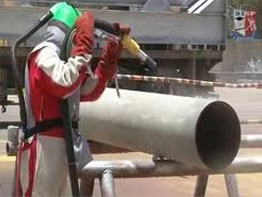
The Ultimate Guide to Sandblasting Techniques
Introduction to the Ultimate Guide to Sandblasting Techniques
Sandblasting is an abrasive process that has found its place in various industries, thanks to its ability to efficiently clean, refine, and prepare surfaces. In this comprehensive guide, we will delve into the world of sandblasting, exploring its history, types, safety precautions, equipment, techniques, and its widespread applications in different industries.
History of Sandblasting
Let’s start with a glimpse into the history of sandblasting. This technique has come a long way, evolving from its early beginnings into a versatile tool for surface treatment. Originally, sandblasting was primarily used for cleaning and shaping glass and metal, but it has since expanded its reach into other sectors.
Types of Sandblasting
Before we dive into the nitty-gritty of sandblasting, it’s essential to understand the various methods available. Dry, wet, and abrasive blasting are the three most common techniques. Each method has its own unique applications and specific requirements. We’ll break them down for you, so you can choose the one that suits your needs.
Safety Precautions
Safety should always be a top priority in sandblasting. With high-pressure equipment and abrasive materials in play, it’s crucial to protect yourself and those around you. Be sure to invest in the right safety gear, including goggles, respiratory masks, and protective clothing. Always work in well-ventilated areas and follow safety guidelines diligently.
Equipment and Materials
To get started with sandblasting, you’ll need the right equipment and materials. Key components include the blasting cabinet, abrasive materials (such as silica sand or aluminum oxide), and an air compressor. We’ll provide links to recommended products to make your setup a breeze.
Sandblasting Techniques
Now, let’s get to the heart of the matter – the sandblasting techniques themselves. We’ll cover the basics, including surface preparation, finishes, and the best practices for achieving the desired results. Whether you’re a beginner or looking to refine your skills, this section has something for everyone.
Surface Preparation
The success of any sandblasting project hinges on proper surface preparation. This step involves cleaning, masking, and priming the surface. We’ll share tips and insights on how to achieve a perfectly prepped surface for your sandblasting work.
Sandblasting in Different Industries
Sandblasting finds its applications in a variety of industries. From construction to automotive and even the world of art, it plays a pivotal role in surface refinement and restoration. We’ll showcase the diverse applications of sandblasting, inspiring you to explore its potential in your own line of work.
Troubleshooting and Common Mistakes
As with any skill, sandblasting comes with its share of challenges and common mistakes. We’ll guide you through troubleshooting common issues and offer advice on how to avoid costly errors. Learning from the experiences of others can save you time and resources.
Expert Tips
To truly master the art of sandblasting, we’ll conclude with some expert tips from seasoned professionals. These advanced insights will help you take your sandblasting techniques to the next level. Remember, practice and experimentation are key to becoming an expert in this field.
Conclusion
In summary, sandblasting is a versatile technique that can be a game-changer in various industries. By understanding its history, types, safety measures, equipment, and techniques, you can become proficient in this skill. Sandblasting offers countless opportunities for creative expression and problem-solving in your projects.
Now that you’ve explored “The Ultimate Guide to Sandblasting Techniques,” we invite you to roll up your sleeves and dive into the world of sandblasting. Experiment, refine your skills, and watch your projects transform before your eyes.
If you have any questions or need further guidance on sandblasting , don’t hesitate to reach out. We’re here to support your journey.
Leave a reply




Most Commented